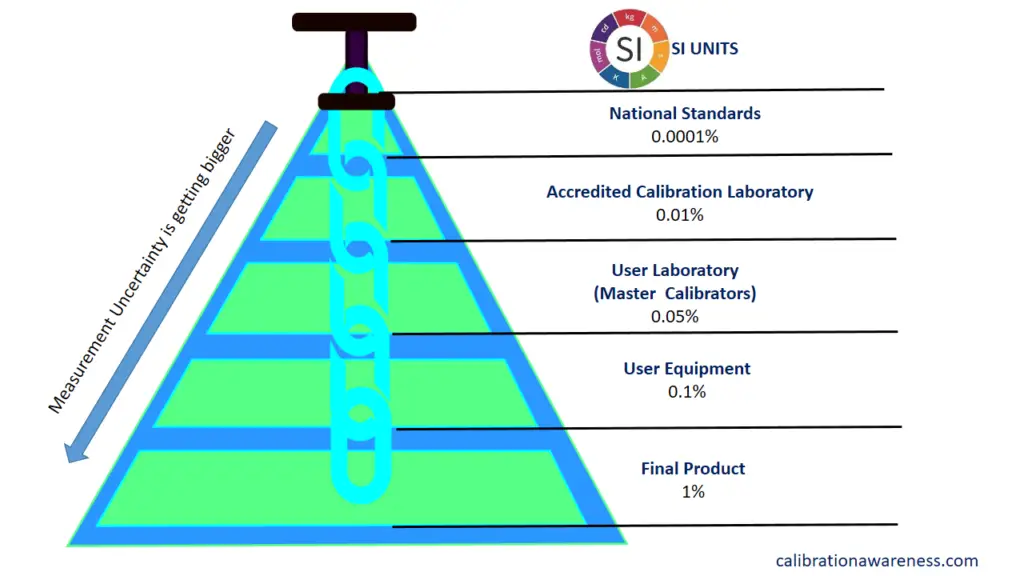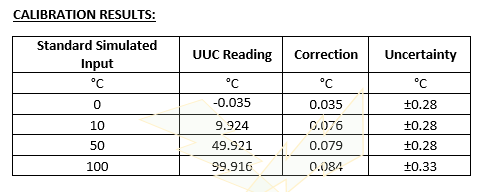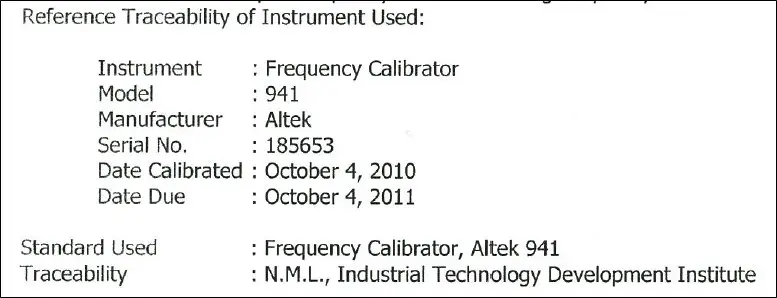
You may have a properly maintained calibration lab, well-trained personnel, high-end measuring equipment but the traceability of the reference standard you use is in question, then the calibration performed could be rejected.
As a beginner once in calibration, my only understanding about the meaning of Traceability in calibration is the unbroken chain of calibration where my reference standard is calibrated by a more accurate standard that is linked all the way to International Standards or SI. It is not wrong to understand this way, but it is not enough.
Have you ever thought if there is a difference between a traceable standard and a traceable calibration?
How do we really know that it is linked to International Standards through an unbroken chain of calibration?
What are the ‘evidence of traceability’ that shows us our calibration is a traceable calibration?
In this post, I will share with you the following:
- The formal definition of Metrological Traceability
- What are Calibration Traceability Chain and Traceability Pyramid
- Why do we need to have traceability in our calibration?
- The 2 Implementation Requirements for Metrological Traceability as Per ISO 17025
- How to Ensure that We Have Received a Traceable Calibration?
- How to Ensure Lab Has Traceability if it is not Accredited- Traceability Audit Requirements
- What Are the Evidence of Traceability in a Calibration Certificate
- When Does Traceability Become Invalid?
Definition of Traceability
This is the formal definition based on VIM (International Vocabulary of Metrology)
Metrological traceability (VIM 3 clause 2.41)
Property of a measurement result whereby the result can be related to a reference through a documented unbroken chain of calibrations, each contributing to the measurement uncertainty.
As per VIM, for a shorter terminology, Metrological traceability can be termed as just ‘Traceability’ as long as it will not conflict to other definitions on a specific subject.
In a much simpler understanding, traceability is the series of comparison with the instrument’s measurement results (measured value and uncertainty) to the value of a higher accuracy standard that is linked to a more accurate standard until it reaches International Standards or SI.
I just want to emphasize that Traceability is referring to the “result of measurement”, NOT the instrument, the standard, or even the calibration performed.
If an instrument is traceable, this means that the results of measurement we have are the same wherever we go. With varying tolerable errors as it goes down to a traceability chain. For example on a 1kg standard weight, the 1 kg we have is also 1kg wherever we go, thus any product or service resulted by using this standard weight will be acceptable anywhere it goes.
As a practical example of traceability in calibration, let us consider a digital weighing scale.Below are the steps where we have an unbroken chain of calibration:
- The Digital Weighing Scale is calibrated by an M1 grade standard weight maintained by the user.
- This M1 standard weight is calibrated by comparing its mass to a class F1 standard by a 3rd party Calibration Lab.
- This F1 standard weight is calibrated by comparison to Class E1 weights from a National Lab.
- Class E1 is compared against the primary standard that is directly linked to SI
The series of connections is linked by what we call the ‘traceability chain’. There is also a series of comparisons where accuracy is getting better as it goes up on the top chain, it is in order following the shape of a pyramid, a ‘traceability pyramid’. Read more below.
What Are Calibration Traceability Chain and Traceability Pyramid?
Going back to the formal definition of VIM (VIM 3 clause 2.43)
Metrological traceability chain is “the sequence of measurement standards and calibrations that are used to relate a measurement result to a reference”
Traceability can be explained well by using a figure to represent the “unbroken chain of comparison” from a higher level going to a lower level (or lower level going to higher level). This figure is the traceability chain and traceability pyramid.
The traceability chain represents that every standard is linked to each other. When one chain is cut along the way, for example, overdue calibration, it means traceability is also disconnected in that part. This is because we can no longer trace it back to the top chain.

The traceability chain links every reference standard used in an order of higher to lower accuracy values (starting from the top going down) until it reaches the lowest chain. These hierarchies of accuracy are well represented by the Traceability pyramid.

The traceability pyramid presents the hierarchy of every reference standard and the size (magnitude) of the provided uncertainty. The higher the location of the reference standard in the pyramid, the more accurate and smaller the measurement uncertainty.
.

To further explain Traceability in calibration, I integrated both the traceability chain and traceability pyramid. This combination clearly shows the unbroken chain of calibrations presented by the chain and the hierarchy of standards with corresponding measurement uncertainty as presented by the pyramid, which is getting smaller as it goes up the traceability chain.
The order in the traceability chain and traceability pyramid from bottom to top can be shortened by jumping directly to a higher level of standard. This will improve your measurement uncertainty but of course, it will result in a higher cost of calibration.
In every step or sequence of the Traceability chain where we relate a measurement result to a reference, this process must be under control to ensure that the quality of transferred measurement results are maintained.
Reasons Why We Need Traceability in our Calibration
The following are some of the reasons why we need to have traceability in our calibration:
- It is a necessity in calibration, you cannot call it calibration if the reference standards are not traceable to SI.
- It is a requirement of standards like ISO 17025 and ISO 9001.
- As per ISO 17025, below are the requirements..
- Clause 6.5.1 The laboratory shall establish and maintain metrological traceability of its measurement results by means of a documented unbroken chain of calibrations, each contributing to the measurement uncertainty, linking them to an appropriate reference.
- For ISO 9001, below are the requirements:
- Clause 7.1.5.2 When measurement traceability is a requirement or is considered by the organization to be an essential part of providing confidence in the validity of measurement results, measuring equipment shall be: a) calibrated or verified, or both, at specified intervals, or prior to use, against measurement standards traceable to international or national measurement standards;
- As per ISO 17025, below are the requirements..
- For companies engaged in manufacturing and engineering, it ensures that parts produced or supplied have the same or acceptable specifications when used by customers anywhere. Compatibility is not an issue.
- Traceability provides confidence to our measurement process because it ensures the validity and accuracy of the measurement results.
- Traceability has a numerical value, this value is displayed in a calibration certificate as the measured value plus the measurement uncertainty results. The smaller the uncertainty results are, the more accurate the measurement instruments.
- A requirement by relevant laws and regulations to guarantee product safety and quality- even though we have different units of measurements, we are confident that compatibility in terms of size, form or level is not an issue anywhere it goes.
2 Implementation Requirements for Metrological Traceability as Per ISO 17025
In every step or sequence of the Traceability chain where we relate a measurement result to a reference, this process must be under control to ensure that the quality of transferred measurement results are maintained.
Once the reference standard has left the laboratory where it was calibrated, it is now our responsibility to ensure and maintain the validity of its measurement results.
You may have established the traceability of your reference standard, but during calibration in your lab, the method used is not valid or the person performing the calibration is not properly trained, because of this, there is no confidence in the results, therefore calibration results are compromised.
With all these factors, the unbroken chain of comparison to SI is not enough, we need to implement a measurement assurance program in order to ensure the validity of traceability in the long run.
Going back to the requirements of ISO 17025, where it states: “The laboratory shall establish and maintain metrological traceability of its measurement results by means of a documented unbroken chain of calibrations, each contributing to the measurement uncertainty, linking them to an appropriate reference.”
There are 2 implementation requirements that we must consider in order to satisfy Metrological Traceability, and for us to ‘claim traceability’ in our measurements, these are:
- Establish Metrological Traceability
- Maintain Metrological Traceability
Establishing the Traceability Chain
Establishing traceability is where the technical aspect of traceability, focusing on the reference standards (the calibrators). This is where the actual link to the SI is objectively seen – a traceable standard.
We always read that in order to have a valid calibration, it should be traceable to the International Standard or SI through the unbroken chain of calibration. This unbroken chain of calibration is how we establish this traceability chain.
We can easily establish the traceability chain, we just need to send our reference standard to a higher level lab or to an accredited lab.
Once this traceability chain is established, we expect to see the following evidence to claim our traceability. These are the:
- The assigned value of calculated uncertainty
- Environmental Conditions
- Calibration Methods used
- Competency of personnel
- Identification of the reference standards used during calibration.
You already established Metrological Traceability with a traceable standard, but what’s next?
Our job does not end once we establish traceability in calibration, this is just the beginning. The more challenging part now is to maintain our traceability.
Maintaining Metrological Traceability in Calibration
Maintaining traceability is the 2nd implementation requirement, this is traceability evidence referring to the documented quality assurance program of ISO 17025.
These are:
- Internal Audit – focusing on traceability evidence making sure processes are in place
- Method validation and verification – Making sure that the suitability of procedures or methods are for the intended use.
- Acquiring traceability through:
- Calibration and Recalibration
- Use of certified reference materials
- Use of other calibrated instrumentation
- Ensuring the validity of results through:
- PT or ILC
- Intermediate Checks
In totality, the ISO 17025 is a standard designed with the purpose of establishing and maintaining traceability in either Test or Calibration performed. A laboratory that is accredited under ISO 17025 standard by a reputable accreditation body is said to be conforming, thus, providing a traceable calibration is ensured.
How to Ensure That We Have Received a Traceable Calibration?
When choosing the service of a 3rd party lab, make sure that it is an accredited lab. When a lab is accredited, it means that the accreditation bodies have assessed the competency of the lab in terms of its procedure, personnel, equipment, and environmental conditions as per the requirements of a standard like ISO 17025:2017..
This will ensure that the calibration performed on our calibrators is link or traceable to the national standard up to the SI units.
But in order to ensure that our reference standard is traceable, it should have a calibration certificate with the below details.
These are also the Evidence of Traceability in A Calibration Certificate
- The logo of the accreditation body is evident.

2. Estimated uncertainty results are displayed.

3. It has the details of the reference standard used in calibration

4. It has the details of the calibration procedure used.

5. A recorded environmental conditions

6.A statement that it is “Traceable to International Standards (SI units)”

These traceability evidence in the calibration certificate are the documented traceability chain, this is why it is very important to ensure its completeness when receiving or generating a calibration report
But what if there are no available accredited labs?
How to Ensure Lab Has Traceability if it is not Accredited- Traceability Audit Requirements
There are times where there are no available calibration labs that can perform the calibration of our instruments or standards. This is not a problem as long as we can verify through audit below traceability requirements.
These traceability requirements can also be used as evidence to satisfy auditors during scheduled audits if we want to establish our In-House calibration.
These are:
- The Measurement Uncertainty results
- Documentation in establishing a traceable reference standard used in calibration (calibration certificates)
- A recorded environmental conditions
- Documented Personnel training or competency
- Documented Calibration procedures
- Documented validation and/or verification of methods
- Recorded Audits of calibration provider
- Documentation for assuring the validity of results (intermediate checks or calibration interval)
.
When Does Traceability Become Invalid?
Traceability in calibration is not permanent. This is the reason why we have to implement a quality assurance program in order to maintain and ensure traceability.
Below are some reasons where traceability can be rejected or invalidated:
- When the calibration date is Overdue
- The reference standard used is not Traceable to SI (reference standard used is not linked to SI or any traceability chain)
- Void Seal has tampered
- Details of Instruments does not match what is written in its calibration certificate
- When a reported result has insufficient information (see the Evidence of Traceability in A Calibration Certificate above)
- Measurement uncertainty is too large. How good is an uncertainty result if it resulted in an out of specification once added to the measured value? – Learn more about this in this post>> Decision Rule
Conclusion:
Metrological Traceability is one of the core requirements in calibration that needs to be fully understood and integrated into our measurement process. Without traceability, the calibration performed will not be valid.
Acquiring and establishing traceability based on the traceability chain does not end when we receive our instrument from a trusted provider, but just the beginning of a more challenging task.
Understanding the principles and requirements of traceability based on ISO 17025 will help us maintain metrological traceability in our calibration. These are the quality assurance programs that will help us to have continued confidence and validity of our measured value.
In this post, I have shared and discuss the following topics:
- The formal definition of Metrological Traceability
- What is Calibration Traceability Chain and Traceability Pyramid
- Why do we need to have traceability in our calibration?
- The 2 Implementation Requirements for Metrological Traceability as Per ISO 17025
- How to Ensure that We Have Received a Traceable Calibration?
- How to Ensure Lab Has Traceability if it is not Accredited- Traceability Audit Requirements
- What Are the Evidence of Traceability in A Calibration Certificate
- When Does Traceability Become Invalid?
Guidance for establishing and maintaining metrological traceability is provided by ISO 17025:2017, therefore, you are conforming to be a provider of “Traceable Calibration” once you are accredited under this standard by a reputable accreditation body.
References:
- ISO 17025:2017 – General requirements for the competence of testing and calibration laboratories
- ILAC P10 – ILAC Policy on Metrological Traceability of measurement results
- International vocabulary of metrology – Basic and general concepts and associated terms (VIM) 3rd Edition
Thank you for reading my post. If you like what you read, please share and subscribe
Edwin
7 Responses
M. Saleh
It’s a great job, useful & really aware.
Thanks Edwin.
edsponce
Hi M. Saleh,
You are welcome. I appreciate your time for reading my post.
Thank you.
Best regards,
Edwin
M. saleh
Mister Edwin,
I have been in contact with you for a short period of time, and I found that your personal CV says that you have high latency in practical calibration. Question: How can I share this experience other than your website?
Thank you very much.
Note: I own a calibration laboratory, and currently I am trying to re-qualify it. We distribute to Fluke and we have some measurement services for the infrastructure of pharmaceutical factories. We apply standard specification 17025: 2005 edition.
Kind Regards
M. Saleh AL – Mufti
Managing Director
Middle East Center
Jesse Tsai
Thank you for sharing!
edsponce
Hi Jesse,
You’re welcome. Thanks for reading.
Best regards,
Edwin
Oscar
in example of the calibration results there is an error in the rounding rule for the correction and the UUC and standard values, they most comply with 7.2.6 from the GUM, in the example the results have to be rounded to the second decimal digit (centesimal in this example), congratulations for the effort
edsponce
Hi Oscar,
Thanks for the clarification and additional details about the rounding rule.
Best regards,
Edwin